It’s that time of year – since before Christmas, people have been looking back at 1998. What were the most significant events?
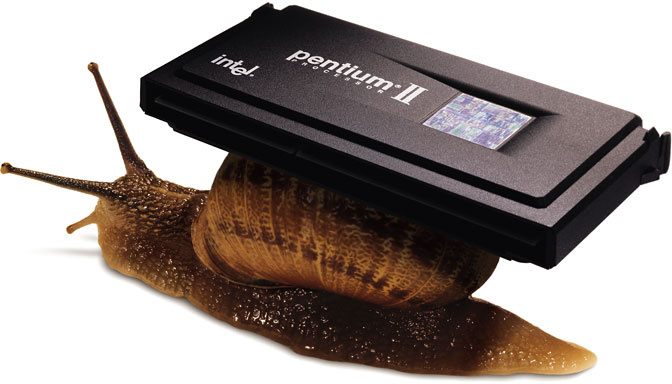
Glossing over the affairs of the White House and Department of Justice, ignoring the two Bills who dug themselves in too deep, let’s look at Apple Computer.
Just what were the key events of 1998?
- The Think Different campaign brings the Apple brand back to public awareness.
- Every Mac now based on the G3 processor.
- Using humor very effectively, the snail and bunny ads made the point that “the G3 processor inside every Power Mac is up to twice as fast as the Pentium II.”
- Apple followed the Power Mac G3 with the PowerBook G3, now running at up to 300 MHz with an amazing 14.1″ display.
- Pulling a rabbit from his hat, Steve Jobs unveils the iMac in May, three months before anyone would be able to buy one.
- The entire online Macintosh community provides more free press about the iMac than Apple can shake a stick at.
- Not only did Mac OS 8.0 make the best seller list, by the end of the year Mac OS 8.5 had surpassed it.
- After four consecutive profitable quarters, tripling stock value, and more than doubling market share since July, the formerly “beleaguered” Apple is now the industry sweetheart.
Think Different
I’ll admit it, nice as it was to see Apple running ads again, I just didn’t get Think Different. It didn’t push product, just brand.
Like Nike. Like Sony. Like Saturn. And the list goes on.
In retrospect, the importance of the Think Different campaign wasn’t selling computers, but reminding the consumer that Apple computer was still in business – and still selling different computers, ones that didn’t have Intel Inside™ or run Microsoft Windows.
And they’re still pushing the idea that conformity is bad, and different is good.
The G3 Processor
Apple introduced the Power Mac G3 in November 1997. Other desktop models were taken out of production. Shortly after introducing the PowerBook G3, other PowerBooks were phased out.
This put the entire product line on the PowerPC 750 (a.k.a. G3) processor, the first CPU designed for the way the Mac OS and Mac applications actually work.
Although intended as a replacement of the entry-level 603e processor, everyone soon discovered that the G3 outperformed the 604e in just about every area. (The 604e may retain a slight edge in mathematical prowess and can easily be used in multiple processor designs.) For the most part, the G3 made previous PowerPC processors obsolete.
This was the processor Byte magazine found “up to twice as fast as the Pentium II.”
The Snail and the Bunny Suit
Apple had brand recognition. They had hot hardware.
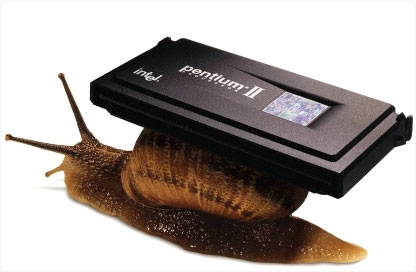 Using sizzle to sell the steak, Apple’s first G3 ad showed a large snail with a huge plastic case on its back. As the snail crept across the screen, the announcer noted that for those who thought the Pentium was the fastest thing going, there was an even faster CPU used in every Power Mac G3.
Using sizzle to sell the steak, Apple’s first G3 ad showed a large snail with a huge plastic case on its back. As the snail crept across the screen, the announcer noted that for those who thought the Pentium was the fastest thing going, there was an even faster CPU used in every Power Mac G3.
Intel had used sizzle to sell the Pentium, but few facts. Apple’s claim about G3 power cast the dancing Intel engineers in their bunny suits in a completely different light.
 And then they went in for the kill, featuring a fireman extinguishing a flaming bunny suit, and reminding the world that, much as Intel obviously loathed it, the G3 processor was still up to twice as fast as the Pentium II.
And then they went in for the kill, featuring a fireman extinguishing a flaming bunny suit, and reminding the world that, much as Intel obviously loathed it, the G3 processor was still up to twice as fast as the Pentium II.
And they had the Byte magazine Bytemark benchmarks to prove it:
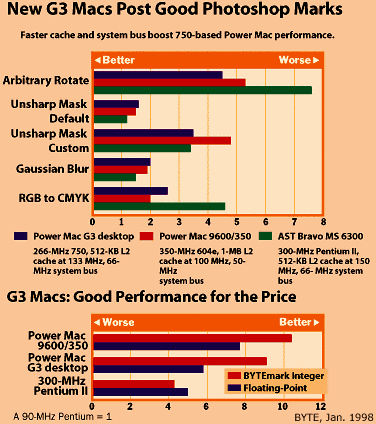
In a pathetic display of corporate power, it didn’t take long for CMP to buy Byte magazine, fire its staff, and put the leading platform independent computer magazine on hiatus “until Fall”. Earlier this month, they announced that Byte is dead – and subscribers will instead receive a Windows magazine. (I’ll be asking for a refund.)
The PowerBook G3
With Pentium-beating performance, he initial 250 MHz PowerBook G3 was impressive, but the PowerBook G3 Series handily eclipsed it with three CPU speeds (233, 250, and 292 MHz), three displays (12.1″, 13.3″, and 14.1″), and even greater RAM capabilities.
Alas, there were problems with the 13.3″ screen, and the 233 MHz model didn’t have a level 2 (L2) cache, which significantly reduced performance, but other than that the new PowerBooks were very impressive.
These were replaced by another PowerBook G3 Series (naming conventions have become particularly confusing). The third-generation G3 PowerBooks all had a L2 cache and used the amazing 14.1″ active matrix color display. Thanks to the cache, the PB G3/233 was 70% faster than its cacheless predecessor. (Apple also made a limited edition, lower priced version with the 12.1″ screen of the original PB G3 Series.)
The iMac, Free Publicity, and a Best Seller
What new can be written about the iMac, the computer that single-handedly restored Apple’s polish?
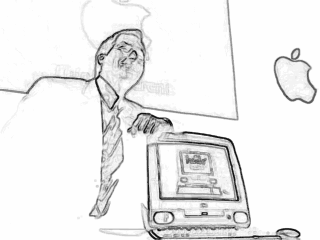 Announced in May, for three months the Macintosh community could talk of little else. Several new sites were created, including Low End Mac’s The iMac Channel. We debated the merits and demerits of USB, the pros and cons of the missing floppy, the range of expansion possibilities with USB, what in the world Apple was thinking abandoning ADB, LocalTalk, and SCSI, and a whole lot more.
Announced in May, for three months the Macintosh community could talk of little else. Several new sites were created, including Low End Mac’s The iMac Channel. We debated the merits and demerits of USB, the pros and cons of the missing floppy, the range of expansion possibilities with USB, what in the world Apple was thinking abandoning ADB, LocalTalk, and SCSI, and a whole lot more.
In retrospect, this was exactly the kind of fan hype Steve Jobs must have been counting on – millions of dollars worth of free publicity on the Web, news groups, email lists, and the press, both general interest publications and the computer press.
It shouldn’t surprise anyone that when the iMac finally shipped on August 15, the question wasn’t if it would sell, but if Apple could make enough.
By staggering the Mac’s introduction in various markets around the world, Apple managed to pretty much balance demand and production. They also ended up with the top selling computer model in August – followed by September, October, and November.
Expect December sales data to show iMac was also the #1 seller during the Christmas season.
No Longer Beleaguered
The adjective beleaguered almost became part of the company name in 1987. Writers everywhere talked about “beleaguered Apple Computer”.
No more.
Apple has probably completed its most successful quarter of the year with the fifth consecutive quarterly profit. They have sold out of the Power Mac G3, just in time to announce the new series, code named Yosemite, at this week’s Macworld Expo.
Macs, especially the iMac and the PowerBook G3, are showing up all over TV, especially on prime time programs. (Alas, in many cases the stark white Apple logo on the PB G3 has been blackened, making it harder to recognize it.)
Apple stock has tripled in value and will likely surpass the $50 mark early this year.
Sizzle
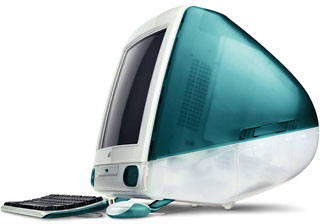 Apple has always made great computers. The Apple II offered color in a world of black and white competitors. The Macintosh offered a graphical user interface in a world of text-based computers. And now the iMac offers the Internet in what is essentially an appliance computer – it’s easier to get the iMac up and running that it is to set up many VCRs and answering machines.
Apple has always made great computers. The Apple II offered color in a world of black and white competitors. The Macintosh offered a graphical user interface in a world of text-based computers. And now the iMac offers the Internet in what is essentially an appliance computer – it’s easier to get the iMac up and running that it is to set up many VCRs and answering machines.
Finally, the iMac is the computer Steve Jobs envisioned when he created the Mac, but because of the limited technology of that era (hard drives and memory were incredibly expensive, as were color screens), Apple was unable to deliver it in 1984.
The iMac and PowerBook G3 are appliance computers. All the hardware you need (lots of memory, huge hard drives, high resolution color displays, impressive speed, a fast modem, ethernet) is combined with the easiest to learn on the fly computer operating system known.
Looking back, 1998 was the year Apple learned to sell the steak by selling the sizzle.
1999 is time for an encore to keep Apple two steps ahead of Microsoft, Intel, and all those clone makers.
Keywords: #apple1998 #mac1998 #imac #sellthesizzle
Short link: http://goo.gl/5QfnT5
searchword: applesizzle

